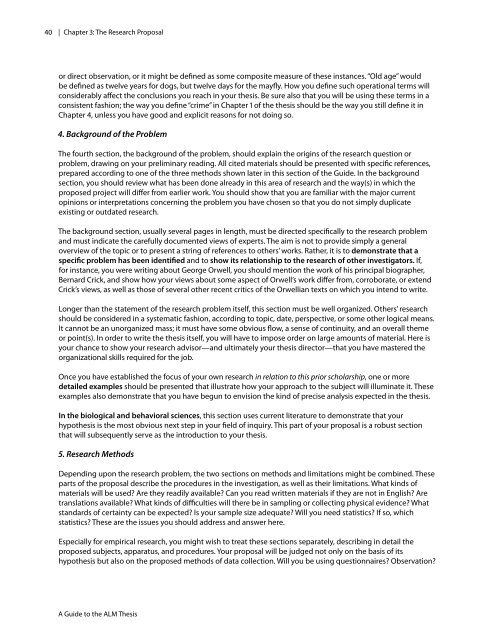A Guide to the ALM Thesis - iSites - Harvard University
A Guide to the ALM Thesis - iSites - Harvard University
A Guide to the ALM Thesis - iSites - Harvard University
Create successful ePaper yourself
Turn your PDF publications into a flip-book with our unique Google optimized e-Paper software.
40<br />
| Chapter 3: The Research Proposal<br />
or direct observation, or it might be defined as some composite measure of <strong>the</strong>se instances. “Old age” would<br />
be defined as twelve years for dogs, but twelve days for <strong>the</strong> mayfly. How you define such operational terms will<br />
considerably affect <strong>the</strong> conclusions you reach in your <strong>the</strong>sis. Be sure also that you will be using <strong>the</strong>se terms in a<br />
consistent fashion; <strong>the</strong> way you define “crime” in Chapter 1 of <strong>the</strong> <strong>the</strong>sis should be <strong>the</strong> way you still define it in<br />
Chapter 4, unless you have good and explicit reasons for not doing so.<br />
4. Background of <strong>the</strong> Problem<br />
The fourth section, <strong>the</strong> background of <strong>the</strong> problem, should explain <strong>the</strong> origins of <strong>the</strong> research question or<br />
problem, drawing on your preliminary reading. All cited materials should be presented with specific references,<br />
prepared according <strong>to</strong> one of <strong>the</strong> three methods shown later in this section of <strong>the</strong> <strong>Guide</strong>. In <strong>the</strong> background<br />
section, you should review what has been done already in this area of research and <strong>the</strong> way(s) in which <strong>the</strong><br />
proposed project will differ from earlier work. You should show that you are familiar with <strong>the</strong> major current<br />
opinions or interpretations concerning <strong>the</strong> problem you have chosen so that you do not simply duplicate<br />
existing or outdated research.<br />
The background section, usually several pages in length, must be directed specifically <strong>to</strong> <strong>the</strong> research problem<br />
and must indicate <strong>the</strong> carefully documented views of experts. The aim is not <strong>to</strong> provide simply a general<br />
overview of <strong>the</strong> <strong>to</strong>pic or <strong>to</strong> present a string of references <strong>to</strong> o<strong>the</strong>rs’ works. Ra<strong>the</strong>r, it is <strong>to</strong> demonstrate that a<br />
specific problem has been identified and <strong>to</strong> show its relationship <strong>to</strong> <strong>the</strong> research of o<strong>the</strong>r investiga<strong>to</strong>rs. If,<br />
for instance, you were writing about George Orwell, you should mention <strong>the</strong> work of his principal biographer,<br />
Bernard Crick, and show how your views about some aspect of Orwell’s work differ from, corroborate, or extend<br />
Crick’s views, as well as those of several o<strong>the</strong>r recent critics of <strong>the</strong> Orwellian texts on which you intend <strong>to</strong> write.<br />
Longer than <strong>the</strong> statement of <strong>the</strong> research problem itself, this section must be well organized. O<strong>the</strong>rs’ research<br />
should be considered in a systematic fashion, according <strong>to</strong> <strong>to</strong>pic, date, perspective, or some o<strong>the</strong>r logical means.<br />
It cannot be an unorganized mass; it must have some obvious flow, a sense of continuity, and an overall <strong>the</strong>me<br />
or point(s). In order <strong>to</strong> write <strong>the</strong> <strong>the</strong>sis itself, you will have <strong>to</strong> impose order on large amounts of material. Here is<br />
your chance <strong>to</strong> show your research advisor—and ultimately your <strong>the</strong>sis direc<strong>to</strong>r—that you have mastered <strong>the</strong><br />
organizational skills required for <strong>the</strong> job.<br />
Once you have established <strong>the</strong> focus of your own research in relation <strong>to</strong> this prior scholarship, one or more<br />
detailed examples should be presented that illustrate how your approach <strong>to</strong> <strong>the</strong> subject will illuminate it. These<br />
examples also demonstrate that you have begun <strong>to</strong> envision <strong>the</strong> kind of precise analysis expected in <strong>the</strong> <strong>the</strong>sis.<br />
In <strong>the</strong> biological and behavioral sciences, this section uses current literature <strong>to</strong> demonstrate that your<br />
hypo<strong>the</strong>sis is <strong>the</strong> most obvious next step in your field of inquiry. This part of your proposal is a robust section<br />
that will subsequently serve as <strong>the</strong> introduction <strong>to</strong> your <strong>the</strong>sis.<br />
5. Research Methods<br />
Depending upon <strong>the</strong> research problem, <strong>the</strong> two sections on methods and limitations might be combined. These<br />
parts of <strong>the</strong> proposal describe <strong>the</strong> procedures in <strong>the</strong> investigation, as well as <strong>the</strong>ir limitations. What kinds of<br />
materials will be used? Are <strong>the</strong>y readily available? Can you read written materials if <strong>the</strong>y are not in English? Are<br />
translations available? What kinds of difficulties will <strong>the</strong>re be in sampling or collecting physical evidence? What<br />
standards of certainty can be expected? Is your sample size adequate? Will you need statistics? If so, which<br />
statistics? These are <strong>the</strong> issues you should address and answer here.<br />
Especially for empirical research, you might wish <strong>to</strong> treat <strong>the</strong>se sections separately, describing in detail <strong>the</strong><br />
proposed subjects, apparatus, and procedures. Your proposal will be judged not only on <strong>the</strong> basis of its<br />
hypo<strong>the</strong>sis but also on <strong>the</strong> proposed methods of data collection. Will you be using questionnaires? Observation?<br />
A <strong>Guide</strong> <strong>to</strong> <strong>the</strong> <strong>ALM</strong> <strong>Thesis</strong>

















